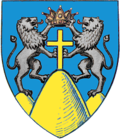Straja | |
|---|---|
 Overview of Straja | |
 Location in Suceava County | |
| Coordinates: 47°55′N25°33′E / 47.917°N 25.550°E | |
| Country | Romania |
| County | Suceava |
| Government | |
| • Mayor (2024–2028) | Mihai Juravle [1] (PSD) |
Area | 45 km2 (17 sq mi) |
| Elevation | 514 m (1,686 ft) |
| Population (2021-12-01) [2] | 5,258 |
| • Density | 120/km2 (300/sq mi) |
| Time zone | EET/EEST (UTC+2/+3) |
| Postal code | 727495 |
| Area code | (+40) x30 |
| Vehicle reg. | SV |
| Website | primariastrajasv |
Straja (German : Strasza or Strascha) is a commune in Suceava County, Bukovina, northeastern Romania. It is composed of a single village, Straja.


